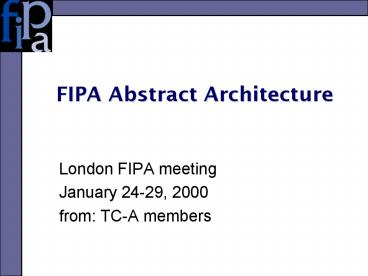FIPA Abstract Architecture - PowerPoint PPT Presentation
1 / 28
Title:
FIPA Abstract Architecture
Description:
Mandatory and Optional ... If an element is optional at the abstract level, it can be mandatory at the concrete level. At the concrete level, the authors can ... – PowerPoint PPT presentation
Number of Views:66
Avg rating:3.0/5.0
Title: FIPA Abstract Architecture
1
FIPA Abstract Architecture
- London FIPA meeting
- January 24-29, 2000
- from TC-A members
2
Overview
- Introduction
- Describe the architecture
- Interoperability
- Next steps
3
Goals of abstract architecture
- Provide end-to-end message interoperability
- Where there may be heterogeneous systems
- Describe common elements and relationships
- Do this without linking to a particular
implementation
4
Other Goals
- Model work on common distributed computing
systems - Java, CORBA
- Facilitate re-use of existing systems
- Previous FIPA work, existing directory,
management, transport and security systems - For info on Goals, see Appendix A- D of the
Architecture Document
5
Mapping Abstract to Concrete
- Abstract architecture moves to realized
implementations
6
Abstract to Concrete
- Whole set or one element
- Promote reusability
- Add elements needed to for that particular
concrete version
7
Abstracting one element
- A concrete version of directory services shared
by several implementations
8
Mandatory and Optional
- If an element is mandatory at the abstract level,
it must be included at the concrete level - If an element is optional at the abstract level,
it can be mandatory at the concrete level - At the concrete level, the authors can add new
mandatory and optional elements
9
Abstract architecture cant do it all!
- Some things cannot be modeled abstractly
- Management and Lifecycle
- Much of security
- Mobility
- Some things need more work
- Gateways, domains and policy
- Conversation policy
10
Relationship to current FIPA specs
- Very close to FIPA 99 work
- Some differences with FIPA 97 work - see doc for
details - Doesnt cover the application domain specs
11
FIPA Abstract Architecture
- Agents and directory
- Message Message Encoding
- Transport
- Platforms Services
- Interoperability
12
Agents directory
- Agents have agent-directory-entries
- Agent-directory-entries registered with
directory-services - Agent descriptions include
- Agent-name
- Locator (contains transport info)
- Agent-attributes
- Search directory-services for interesting agents
13
Agents directory
14
Key differences
- Agent-name separated from addressing
- Gives us transport independence
- Directory service
- Simpler than current FIPA model - suggest that
there are two types - Quick lookup
- Extensive search
15
FIPA-Message
- Expressed in Agent Communication Language
- Has content
- Content is expressed in a content language, may
reference ontologies - Very similar to existing models
16
Message Encoding
- Encoding of a message happens at several levels
- Message content
- FIPA-message
- Transport-level
- FIPA-messages are transformed to
transport-message prior to transport - FIPA-messages can contain FIPA-messages
17
Message Transformation
18
Message Transform
- Within FIPA-message, sender receiver are always
agent-names - FIPA-messages can be transformed to transport
appropriate representations - Envelope can have transport-descriptions and
other attributes - Message authentication and encryption can be
handled this way
19
Transport
- Assume agents can be communicated w/ using
multiple transports - Transport-description holds transport info
- Locator can hold multiple transport descriptions
- Locator is part of agent-description in the
directory-service
20
Multiple Transports
21
Transport Description
- Transport-description contains
- Transport-type SMTP, IIOP, HTTP, etc.
- Transport-specific-address
- Transport-specific-properties
- FIPA will maintain a standard set of these, but
they can be extended
22
Key Differences
- Transport address is separated from agent-name
- Message-transport-service is optional, not
mandatory - Extensible model for expanding transports,
transport properties - Though most systems will probably implement it
23
Platforms and Services
- Agent-platform is a collection of services
- Agent-Platform is optional, not mandatory
- Basic services
- Directory-service
- Message-transport-service
- Though most systems will probably implement it
24
Interoperability
- Details still in discussion
- Basic model is via gateways
- Gateways can do logical transforms
- From one representation to another
- Java objects -gt IDL
- XML -gt tag/string
- Gateways can do transport transforms
25
Gateways
- Can be standalone, or part of other elements in
system - Can be addressable or hidden
26
Interoperability
- As realizations of the architecture occur, need
to create interoperability profiles - what can the system interoperate with
- under what conditions
27
Next Steps
- Review of Abstract Architecture
- Incorporate comments
- Go to draft status
- Add gateway work
- Write Interoperability Guidelines
- Write workplans for concrete instantiations
28
Summary
- Abstract architecture designed for end to end
messaging interoperability - Compatible with FIPA 99 work
- Must be mapped to concrete specifications
- Concrete specification will contain elements that
could not be modeled abstractly - Ready to start creating concrete specifications































